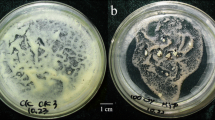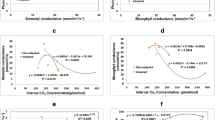Abstract
Embryogenic calli derived from anther cultures of the two-rowed winter barley cultivar ‘Igri’ were plated on solid L3 medium containing the proline analogue hydroxyproline (Hyp), 10–20 mmol l−1. Exposure to Hyp caused severe degeneration of most of the calli. Hyp resistant calli, distinguishable by their lighter colour and higher growth rate, and control calli not exposed to Hyp were plated on L3 regeneration medium. From 22,500 anthers exposed to Hyp 46 Hyp resistant regenerates were obtained, which were transferred to soil. After cultivation for 5–10 weeks at normal growth conditions they were cold hardened at 2 ∘C under short day conditions together with control regenerates. Frost tolerance assays with segments of fully grown leaves of unhardened and cold hardened plants revealed that Hyp resistant regenerants were significantly more frost tolerant than the control regenerants. Improved frost tolerance was found also in the progenies R1 to R9, and genotypic segregation in the R1 generation in a 1:2:1 ratio was indicated. Increased proline content was observed in the R2 generation and in subsequent generations and was significantly (P ≤ 0.001) correlated with increased frost tolerance in the Hyp lines. Comparative studies of R9 progenies from homozygous R2 plants with the wild type ‘Igri’ under field conditions in winter at three locations in Europe as well as crossing experiments confirmed the heritable improvement of frost tolerance and winter survival, respectively, in the Hyp lines. The results support the hypothesis that proline accumulation in cold acclimated winter barley plants is causally related to the acquisition of frost tolerance. Moreover, the described biotechnological procedure may be applicable in breeding programs for improved winter hardiness and possibly also for other stress tolerances.
Similar content being viewed by others
Abbreviations
- BA:
-
benzyladenine
- 2,4-D:
-
2,4-dichlorophenoxyacetic acid
- Hyp:
-
hydroxyproline
- LT50:
-
temperature for 50% electrolyte leakage
References
Bates, L.S., R.P. Waldren & I.D. Teare, 1973. Rapid determination of free proline for water stress studies. Plant Soil 39: 205–207.
Delauney, A.J. & D.P.S. Verma, 1993. Proline biosynthesis and osmoregulation in plants. Plant J 4: 215–223.
Dix, P.J., 1986. Cell line selection. In: M.M. Yeoman (Ed.), Plant Cell Culture Technology, pp. 143–201. Blackwell Scientific, Edinburgh.
Dobslaw, S. & S. Bielka, 1988. Untersuchungen zur Ermittlung des Frosttoleranzgrades bei Wintergerste mittels Prolinakkumulation. 1. Mitt. Prüfung am Indikatorsortiment. Arch Züchtungsforschung 18: 235–240.
Dörffling, K., H. Dörffling & G. Lesselich, 1993. In vitro-selection and regeneration of hydroxyproline-resistant lines of winter wheat with increased proline content and increased frost tolerance. J Plant Physiol 142: 222–225.
Dörffling, K., H. Dörffling, G. Lesselich, E. Luck, C. Zimmermann, G. Melz & H.-U. Jürgens, 1997. Heritable improvement of frost tolerance in winter wheat by in vitro-selection of hydroxyproline resistant proline overproducing mutants. Euphytica 93: 1–10.
Dörffling, K., H. Dörffling, H. Tantau & C. Balko, 2002. Improvement of frost tolerance in winter wheat and winter barley by in vitro selection of proline overproducing mutants. In: M. Zima & K. Cerna (Eds.), Proceedings of the Fifth International Conference on Ecophysiology of Plant Stress, pp. 22–24. Slovak Agricultural University, Nitra. ISBN 80-88943-16-7.
Dörffling, K., S. Schulenburg, G. Lesselich & H. Dörffling, 1990. Abscisic acid and proline levels in cold hardened winter wheat leaves in relation to variety-specific differences in freezing resistance. J Agron Crop Sci 165: 230–239.
Flick, C.E., 1983. Isolation of mutants from cell culture. In: D.A. Evans, W.R. Sharpe, P.V. Amirato & Y. Yamada (Eds.), Handbook of Plant Cell Culture, pp. 393–441. Macmillan, New York.
Fowler, D.B., A.E. Limin & J.T. Rietchie, 1999. Low-temperature tolerance in cereals: Model and genetic interpretation. Crop Sci 39: 626–633.
Gamborg, O.L., R.A. Miller & K. Ojima, 1968. Nutrient requirements of suspension cultures of soybean root cells. Exp Cell Res 50: 151–158.
Hömmö, L.M., 1994. Hardening of some winter wheat (Triticum aestivum L.), rye (Secale cereale L.), Triticale (X Triticosecale Wittmack) and winter barley (Hordeum vulgare L.) cultivars during autumn and the final winter survival in Finland. Plant Breeding 112: 285–293.
Hong, Z., K. Lakkineni, Z. Zang & D.P.S. Verma, 2000. Removal of feedback inhibition of Δ1-pyrroline-5-carboxylate synthetase results in increased proline accumulation and protection of plants from osmotic stress. Plant Phys 122: 1129–1136.
Jähne, A., P.A. Lazzeri, M. Jäger-Gussen & H. Lörz, 1991. Plant regeneration from embryogenic cell suspensions derived from anther cultures of barley (Hordeum vulgare L.). Theor Appl Genet 82: 74–80.
Janacek, J. & I. Prasil, 1991. Quantification of plant frost injury by nonlinear fitting of a s-shaped function. Cryo-Letters 12: 47–52.
Janowiak, F., H. Tantau, H. Dörffling & K. Dörffling, 2004. Photosynthetic efficiency measured by chlorophyll fluorescence is a reliable indicator of low temperature tolerance of crops. Advances of Agricultural Sciences, Problem Issues, ‘Ecophysiological Aspects of Plant Responses to Stress Factors’.
Kishor, P.B.K., Z. Hong, G.-H. Miao, Ch.-A.A. Hu & D.P.S. Verma, 1995. Overexpression of Δ1-pyrroline-5-carboxylate synthetase increases proline production and confers osmotolerance in transgenic plants. Plant Physiol 108: 1387–1394.
Kueh, J.S.H. & S.W.J. Bright, 1982. Biochemical and genetical analysis of three proline-accumulating barley mutants. Plant Sci Lett 27: 233–241.
Limin, A.E. & D.B. Fowler, 1993. Inheritance of cold hardiness in Triticum aestivum × synthetic hexaploid wheat crosses. Plant Breeding 110: 103–108.
Maliga, P, 1984. Isolation and characterization of mutants in plant cell culture. Ann Rev Plant Physiol 35: 519–542.
Morandini, P. & F. Salamini, 2003. Plant biotechnology and breeding: Allied for years to come. Trends Plant Sci 8: 70–75.
Mordhorst, A. & H. Lörz, 1992. Electrostimulated regeneration of plantlets from protoplasts derived from cell suspensions of barley (Hordeum vulgare). Physiol Plant 85: 289–294.
Nanjo, T., M. Kobayashi, Y. Yoshiba, Y. Kakubari, K. Yamaguchi-Shinozaki & K. Shinozaki, 1999. Antisense suppression of proline degradation improves tolerance to freezing and salinity in Arabidopsis thaliana. FEBS Lett 461: 205–210.
Olsen, F.L., 1987. Induction of microspore embryogenesis in cultured anthers of Hordeum vulgare. The effects of ammonium nitrate, glutamine and asparagine as nitrogen sources. Carlsberg Res Commun 52: 393–404.
Papageorgiou, G.C. & N. Murata, 1995. The unusually strong stabilizing effects of glycine betaine on the structure and function of the oxygen-evolving photosystem II complex. Photosynth Res 44: 243–252.
Petcu, E. & M. Terbea, 1995. Proline content and the conductivity test as screening methods for frost tolerance in winter wheat. Bulg J Plant Physiol 21: 3–11.
Prasil, I., P. Prasilova, K. Papazisis & J. Valter, 1994. Evaluation of freezing injury and dynamics of freezing resistance in cereals. In: K. Dörffling, B. Brettschneider, H. Tantau & K. Pithan (Eds.), Crop Adaptation to Cool Climates, pp. 37–48. European Commission, Brussels. ISBN 2-87263-147-X.
Sawahel, W.A. & A.H. Hassan, 2002. Generation of transgenic wheat plants producing high levels of the osmoprotectant proline. Biotechnol Lett 24: 721–725.
Sutka, J., 2001. Genes for frost resistance in wheat. Euphytica 119: 167–172.
Tantau, H. & K. Dörffling, 1991. In vitro-selection of hydroxyproline-resistant cell lines of wheat (Triticum aestivum): Accumulation of proline, decrease in osmotic potential, and increase in frost tolerance. Physiol Plant 82: 243–248.
Thomashow, M.F., 1999. Plant cold acclimation: Freezing tolerance genes and regulatory mechanisms. Annu Rev Plant Physiol Plant Mol Biol 50: 571–599.
Van Swaaij, A.C., H. Nijdam, E. Jacobsen & W.J. Feenstra, 1987. Increased frost tolerance and amino acid content in leaves, tubers and leaf callus of regenerated hydroxyproline resistant potato clones. Euphytica 36: 369–380.
Widholm, J.M., 1984. Induction, selection, and characterization of mutants in carrot cell cultures. In: I.K. Vasil (Ed.), Cell Culture and Somatic Cell Genetics of Plants, Vol. 1, pp. 563–570. Academic Press, Orlando.
Xin, Z. & J. Browse, 1998. eskimo 1 mutants of Arabidopsis are constitutively freezing-tolerant. Proc Natl Acad Sci USA 95: 7799–7804.
Author information
Authors and Affiliations
Corresponding author
Rights and permissions
About this article
Cite this article
Tantau, H., Balko, C., Brettschneider, B. et al. Improved frost tolerance and winter survival in winter barley (Hordeum vulgare L.) by in vitro selection of proline overaccumulating lines. Euphytica 139, 19–32 (2004). https://doi.org/10.1007/s10681-004-2231-2
Received:
Accepted:
Issue Date:
DOI: https://doi.org/10.1007/s10681-004-2231-2




